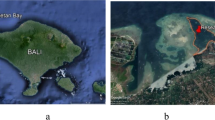Abstract
Bacterial utilization of orthophosphate in an estuarine environment has been differentiated from algal utilization by using flow-filters of 5.0, 1.2 and 0.45 μm poresize. Examination by light microscopy showed that most of the bacterial population passed through a 5.0-μm filter, whereas most algae were retained. In all experiments, bacterial and algal cell numbers and biomass were estimated. P-uptake by algae and bacteria was closely correlated with cell biomass. P-uptake by algae was high only in the summer months, whereas P-uptake by bacteria was high throughout the year. Neither algal nor bacterial P-uptake, however, was correlated with temperature or dissolved orthophosphate, total organic phosphate or total phosphate concentrations. Cell biomass of algae at a given time had a high correlation with dissolved organic phosphate levels in 2 weeks prior to sampling (r=0.830) and a low correlation in the 2 weeks following sampling (r=0.0005). Algal cell numbers had a high correlation with bacterial cell numbers (r=0.950). The biomass of algae and bacteria also had a high correlation (r=0.902). The rate of P-uptake from the water by algae and bacteria varied with season and with the species composition of the natural population.
Similar content being viewed by others
Literature Cited
American Public Health Association: Standard methods for the examination of water and waste water, 13th ed. New York: American Public Health Association 1971
Bell, W. and R. Mitchell: Chemotactic and growth responses of marine bacteria to algal extracellular products. Biol. Bull. mar. biol. Lab., Woods Hole 143, 265–277 (1972)
Campbell, P.H.: Studies on brackish water phytoplankton, 403 pp. Sea Grant Publication UNC-SG-73-07. Chapel Hill, North Carolina: University of North Carolina 1973
Correll, D.L., M.A. Faust and D.F. Severn: Phosphorus flux and cycling in estuaries. In: Estuarine research: chemistry and biology. Special Symposium of the Estuarine Research Federation, Vol. 1. pp 108–136. Ed. by L.E. Cronin. New York: N.Y. Academic Press, Inc. 1975
Derenbach, J.B. and P.F. Le B. Williams: Autotrophic and bacterial production: fractionation of plankton populations by differential filtration of samples from the English Channel. Mar. Biol. 25, 263–269 (1974)
Faust, M.A. and E. Gantt: Effect of light intensity and glycerol on the growth, pigment composition, and ultrastructure of Chroomonas sp. J. Phycol. 9, 489–495 (1973)
Findenegg, I.: Relationship between standing crop and primary productivity. Memorie Ist. ital. Idrobiol. (Suppl.) 18, 271–289 (1965)
Fuhs, G.W. and E. Canelli: Phosphorus-33 autoradiography used to measure phosphate uptake by individual algae. Limnol. Oceanogr. 15, 962–966 (1970)
—, S.E. Demerle, E. Canelli and M. Chen: Characterization of phosphate-limited plankton algae. In: Nutrients and eutrophication: the limiting nutrient controversy. Special Symposium of the American Society of Limnology and Oceanography, Vol. 1. pp 113–133. Ed. by G.E. Likens. Lawrence, Kans.: Allen Press, Inc. 1972
Gantt, E., M.R. Edwards and L. Provasoli: Chloroplast structure of the Cryptophyceae. Evidence for phycobiliproteins within intrathylacoidal spaces. J. Cell Biol. 48, 280–290 (1971)
Harris, E.: Radiophosphorus metabolism in zooplankton and in microorganisms. Can. J. Zool. 35, 769–782 (1957)
Hayes, F.R. and J.E. Phillips: Lake water and sediment. IV. Radiophosphorus equilibrium in mud. plants and bacteria under oxidized and reduced conditions. Limnol. Oceanogr. 3, 459–475 (1958)
Healey, F.P.: Inorganic nutrient uptake and deficiency in algae. CRC critical Rev. Microbiol. 3, 69–113 (1973)
Hutner, S.H. and L. Provasoli: The phytoflagellates. In: Biochemistry and physiology of Protozoa, Vol. 1. pp 27–128. Ed. by A. Lwoff. New York: Academic Press, Inc. 1951
—— Comparative biochemistry of flagellates. In: Biochemistry and physiology of Protozoa. Ed. by S.H. Hutner and A. Lwoff. Vol. 2. pp 17–43. New York: Academic Press, Inc. 1955
Johannes, R.E.: Uptake and release of dissolved organic phosphorus by representatives of a coastal marine ecosystem. Limnol. Oceanogr. 9, 224–234 (1964)
— Influence of marine protozoa on nutrient regeneration. Limnol. Oceanogr. 10, 434–442 (1965)
Jones, J.G.: Studies on freshwater bacteria: association with algae and alkaline phosphatase activity. J. Ecol. 60, 59–75 (1972)
Ketchum, B.H.: The development and restoration of deficiencies in the phosphorus and nitrogen composition of unicellular plants. J. cell. comp. Physiol. 13, 373–381 (1939)
Kramer, J.R., S.E. Herbs and H.E. Allen: Phosphorus: analysis of water biomass, and sediment. In: Nutrients in natural waters, pp 51–100. Ed. by H.E. Allen and J.R. Kramer. New York: John Wiley & Sons 1972
Kuenzler, E.J. and B.H. Ketchum: Rate of phosphorus uptake by Phaeodactylum tricornutum. Biol. Bull. mar. biol. Lab., Woods Hole 123, 134–145 (1962)
Lean, D.R.S.: Phosphorus dynamics in lake water. Science, N.Y. 179, 678–680 (1973)
Rhee, G.Y.: Competition between an alga and an aquatic bacterium for phosphate. Limnol. Oceanogr. 17, 505–514 (1972)
Rigler, F.H.: A tracer study of the phosphorus cycle in lake water. Ecology 37, 550–562 (1956)
Rodina, A.G. (Ed.): Methods in aquatic microbiology, 461 pp. [Translated, edited and revised by R.R. Colwell and M.S. Zamburski.] Baltimore, Maryland: University Park Press 1972
Taft, J.L., III: Phosphorus cycling in the plankton of Chesapeake Bay, 193 pp. Ph.D. thesis, The Johns Hopkins University, Baltimore, Maryland 1974
Watt, W.D. and F.R. Hayes: Tracer study of the phosphorus cycle in sea water. Limnol. Oceanogr. 8, 276–285 (1963)
Author information
Authors and Affiliations
Additional information
Communicated by M.R. Tripp, Newark
Rights and permissions
About this article
Cite this article
Faust, M.A., Correll, D.L. Comparison of bacterial and algal utilization of orthophosphate in an estuarine environment. Marine Biology 34, 151–162 (1976). https://doi.org/10.1007/BF00390757
Accepted:
Issue Date:
DOI: https://doi.org/10.1007/BF00390757




